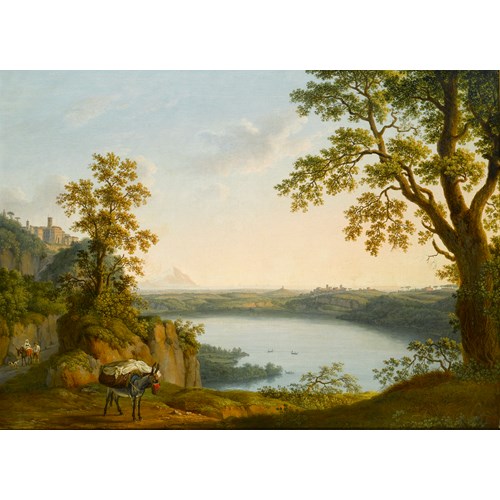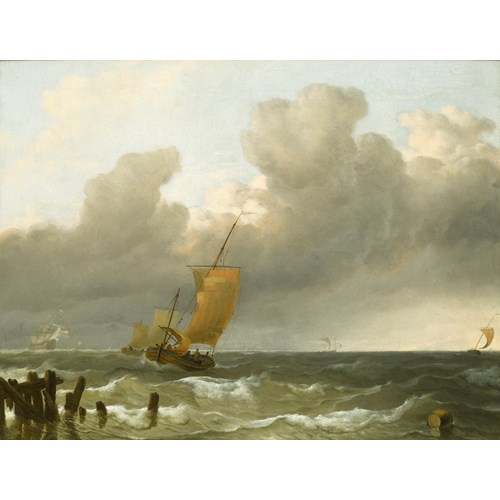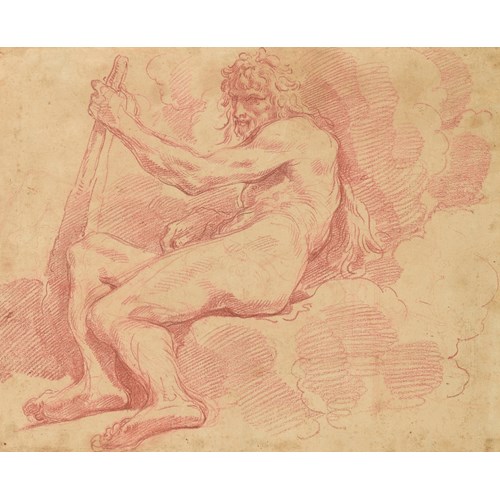Marketplace
Shipping before a Mediterranean Coast with a Fortified Town near a Cliff
Reinier Nooms, called Zeeman
Shipping before a Mediterranean Coast with a Fortified Town near a Cliff
Period 1600-1750, 17th century
Origin The Netherlands
Medium Oil on canvas
Dimension 32.9 x 40 cm (13 x 15³/₄ inches)
In Shipping before a Mediterranean Coast with a Fortified Town near a Cliff, Reinier Nooms presents us with a bustling section of the rocky, undulating Mediterranean coastline. In the foreground, two rowing boats crammed full of passengers head for the shore, on which a group of figures is seen guiding them in. Behind the two mooring boats is a larger vessel, possibly a form of xebec, an extremely popular boat of the period due to its fast speed and manoeuvrability - such qualities were particularly pertinent in areas such as the Mediterranean which was constantly targeted by pirates. This ship is echoed by the silhouettes of similar vessels that disappear into the hazy horizon. On the right-hand side, a ship is being readied as a group of men are busily working to attach its sails. A fortified town is nestled under the cliffs, and various figures tend the surrounding land.
Throughout his career Nooms proudly identified himself by the surname ‘Zeeman’, which in Dutch means ‘Seaman’. It was by this title that he regularly signed his works, and his paintings reflect a sailor’s understanding and experience. For example, in the foreground of the National Maritime Museum’s Ships being Repaired a ship is seen lying on its side while being careened. This process involved hauling ships aground to allow their hulls to be scraped free of weed and barnacles. The men working on the upturned ship stand upon a floating raft. The unusual nature of this subject matter is reminiscent of the boat being readied in the present work. Nooms’ inclusion of the everyday activities of sailors is typical of his work and hints at his time spent at sea.
Nooms’ oeuvre is not restricted to paintings of ports and harbours as he also painted naval battle scenes, his The Battle of Leghorn, 4th March 1653 being such an example. This work depicts a famous Dutch victory over the British Navy that resulted in Dutch control of the Mediterranean. Despite a very different mood and subject to Shipping before a Mediterranean Coast with a Fortified Town near a Cliff, the works share several characteristics, such as the a focus on the accurate rendering of the shipping, and the similar repetition of the shapes of the vessels deep into the background
Nooms was probably self-taught as an artist, since much of his early career was spent as a sailor on Dutch merchant vessels travelling the trade routes to Paris, Italy and the North African coast. His work falls within the last two stylistic phases of seventeenth-century Dutch marine painting. Some of his paintings demonstrate the interest in light and atmosphere that typified the mid-century ‘tonal’ phase. Other works, such as Nooms’ views of sea battles and Italian ports, have a romantic character that anticipates the more dramatic style of the late seventeenth century. Nooms’ depictions of ships are full of accurate detail, demonstrating a keen eye and specialist knowledge in his delineation of features such as the hull or rigging. He often includes details of human activity in a harbour but this is rarely the focus of his work. Nooms was also a distinguished etcher, producing over one hundred and seventy plates.
Throughout his career Nooms proudly identified himself by the surname ‘Zeeman’, which in Dutch means ‘Seaman’. It was by this title that he regularly signed his works, and his paintings reflect a sailor’s understanding and experience. For example, in the foreground of the National Maritime Museum’s Ships being Repaired a ship is seen lying on its side while being careened. This process involved hauling ships aground to allow their hulls to be scraped free of weed and barnacles. The men working on the upturned ship stand upon a floating raft. The unusual nature of this subject matter is reminiscent of the boat being readied in the present work. Nooms’ inclusion of the everyday activities of sailors is typical of his work and hints at his time spent at sea.
Nooms’ oeuvre is not restricted to paintings of ports and harbours as he also painted naval battle scenes, his The Battle of Leghorn, 4th March 1653 being such an example. This work depicts a famous Dutch victory over the British Navy that resulted in Dutch control of the Mediterranean. Despite a very different mood and subject to Shipping before a Mediterranean Coast with a Fortified Town near a Cliff, the works share several characteristics, such as the a focus on the accurate rendering of the shipping, and the similar repetition of the shapes of the vessels deep into the background
Nooms was probably self-taught as an artist, since much of his early career was spent as a sailor on Dutch merchant vessels travelling the trade routes to Paris, Italy and the North African coast. His work falls within the last two stylistic phases of seventeenth-century Dutch marine painting. Some of his paintings demonstrate the interest in light and atmosphere that typified the mid-century ‘tonal’ phase. Other works, such as Nooms’ views of sea battles and Italian ports, have a romantic character that anticipates the more dramatic style of the late seventeenth century. Nooms’ depictions of ships are full of accurate detail, demonstrating a keen eye and specialist knowledge in his delineation of features such as the hull or rigging. He often includes details of human activity in a harbour but this is rarely the focus of his work. Nooms was also a distinguished etcher, producing over one hundred and seventy plates.
Period: 1600-1750, 17th century
Origin: The Netherlands
Medium: Oil on canvas
Signature: Signed ‘R. Zeeman’ (lower right).
Dimension: 32.9 x 40 cm (13 x 15³/₄ inches)
Provenance: with Galerie Jean de Maere, 1987;
De Deckére (according to a label on reverse).
Literature: Tableaux de maîtres Flamands et Hollandais des XVIe et XVIIe siècles, Galerie Jean de Maere, 1987.
More artworks from the Gallery









